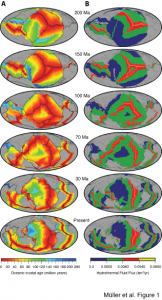 Citation
Citation
Müller, R. D., Dutkiewicz, A., Seton, M. and Gaina, C. (2013). Seawater chemistry driven by supercontinent assembly, break-up and dispersal Geology. doi 10.1130/G34405.1.
Summary
Global oceans are known to have alternated between aragonite and calcite seas. These oscillations reflect changes in the Mg/Ca ratio of seawater, which control biomineralisation and the composition of marine carbonates and are thought to be caused by the time dependence of crustal accretion at mid-ocean ridge crests and associated high temperature mid-ocean ridge brine flux. Here we use global ocean basin reconstructions to demonstrate that these fluctuations are instead caused by the gradual growth and destruction of mid-ocean ridges and their relatively cool flanks during long-term tectonic cycles thus linking ocean chemistry to off-ridge low temperature hydrothermal flux. Early Jurassic aragonite seas were a consequence of supercontinent stability and minima in mid-ocean ridge length and basalt alteration. The break-up of Pangaea led to a gradual doubling in ridge length and a 50% increase in hydrothermal flux mainly through an enormous increase in ridge flank area, leading to enhanced alteration of basalt, lowered seawater Mg/Ca ratios and marine hypercalcification from 140 to 35 Ma. A return to aragonite seas was driven by pronounced continent dispersal, leading to progressive subduction of ridges and their flanks along the Pacific rim.
Downloads
Link to download the Geology paper
Click here to download data
Download grids and scripts
Download global plate model
Contact
We welcome any feedback, please email dietmar.muller@sydney.edu.au
![]()
This work is licensed under a Creative Commons Attribution 3.0 Unported License.
![]()
